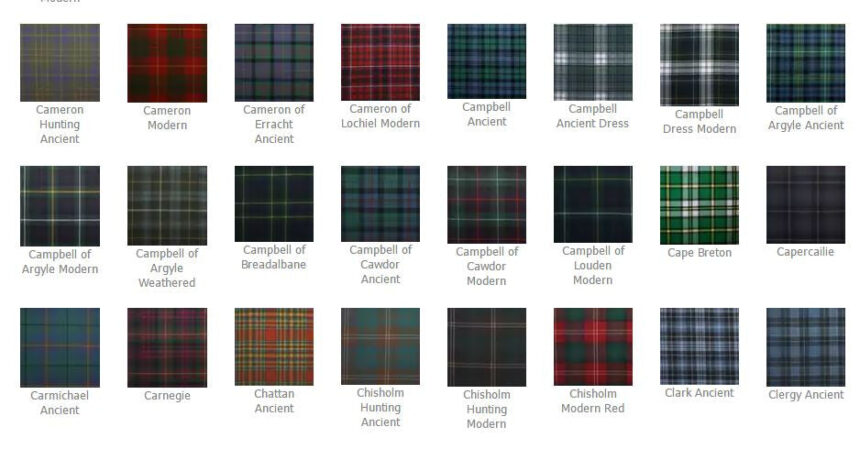Scottish tartan is more than just a pattern; it’s a cultural symbol that evokes rich histories, traditions, and regional pride. With over 5,000 variants, Scottish tartan is often associated with clans, regions, and even specific events. This article explores whether wearing Scottish tartan in the UK is considered strange, especially in contemporary fashion. We will delve into the history, significance, modern interpretations, and the broader context of Scottish clothing.
The Rich History of Scottish Tartan
Scottish tartan dates back centuries and is deeply interwoven with Scotland’s history. Each pattern carries meaning, representing different clans or families, with colors and designs that tell unique stories. Originally, tartan was woven from wool dyed with natural materials, resulting in the vibrant hues that we recognize today.
The oldest known tartan, found in Falkirk, dates back to around 300 BC, indicating that the tradition has roots far deeper than many realize. The modern perception of tartan began to take shape in the 18th century, with the establishment of the Highland Dress Act in 1746, which made wearing tartan illegal for a time. This ban was an attempt to suppress Highland culture after the Jacobite risings. However, the eventual lifting of the ban allowed tartan to flourish as a symbol of Scottish identity.
Today, each Scottish tartan pattern can represent not only clans but also regions, events, or even organizations. The Scottish Register of Tartans, established in 2008, maintains a comprehensive archive of the various patterns, with thousands of entries detailing their historical significance.
Understanding the Variants – Scottish Tartan in 5000+ Variants
One of the most fascinating aspects of Scottish tartan is its diversity. There are over 5,000 variants of tartan, each with its unique colors, patterns, and meanings. This multitude reflects the vast array of clans and regions in Scotland. For instance, the MacDonald tartan features bold reds and greens, symbolizing the clan’s historical ties to the land, while the Campbell tartan presents a more muted palette, representing the clan’s connection to the mountains.
In contemporary fashion, these variants have found their way into modern clothing lines, often divorced from their historical context. Designers are increasingly using tartan as a fashionable statement rather than a cultural one. This shift raises questions about cultural appropriation and whether it’s appropriate to wear a pattern that is so deeply rooted in Scottish heritage without understanding its significance.
Furthermore, brands around the world have adopted tartan, sometimes with little regard for its history. From high-end fashion houses to streetwear brands, the tartan pattern has become a global phenomenon.
All Types of Scottish Clothing
Beyond tartan, Scottish clothing encompasses a rich array of garments that have cultural significance. From kilts and sporrans to tweed jackets and flat caps, each piece tells a story of Scottish heritage. The kilt, perhaps the most iconic piece of Scottish clothing, has undergone transformations over the years, adapting to modern tastes while retaining its traditional roots.
Tweed, a wool fabric often associated with Scotland, has also played a crucial role in Scottish fashion. Originally used for outdoor activities, tweed jackets and coats have become staples in both rural and urban wardrobes. The fabric’s durability and warmth make it ideal for the Scottish climate, but its versatility allows it to transition seamlessly into high fashion.
Moreover, modern Scottish clothing extends beyond traditional garments. Contemporary designers are merging classic styles with modern aesthetics, resulting in innovative clothing lines that celebrate Scottish culture while appealing to a global audience. This fusion of old and new highlights the adaptability of Scottish clothing and its relevance in today’s fashion landscape.
Tartan in Contemporary Fashion – A Growing Trend
In recent years, tartan has surged in popularity across various fashion segments. Designers and retailers are increasingly incorporating tartan into their collections, ranging from casual wear to formal attire. This resurgence can be attributed to the growing interest in vintage and retro styles, as well as a broader appreciation for heritage and craftsmanship.
Fashion influencers and celebrities have also played a role in popularizing tartan. From runway shows to red carpet events, tartan patterns are making appearances in unexpected contexts, often paired with modern silhouettes. This blend of traditional and contemporary has sparked discussions about the appropriateness of wearing Scottish tartan in non-traditional settings.
However, this trend raises questions about authenticity and respect for the cultural significance of tartan. As it becomes more mainstream, there’s a risk of losing the connection to its roots. Understanding the history and significance of the tartan one wears becomes essential in avoiding cultural insensitivity.
Cultural Appropriation vs. Appreciation
The conversation around wearing Scottish tartan often leads to a discussion about cultural appropriation versus cultural appreciation. When individuals outside of Scottish heritage wear tartan, it can sometimes be seen as a form of appropriation, especially if the wearer lacks an understanding of the fabric’s significance.
Cultural appropriation occurs when elements of one culture are taken by members of another, often without permission or understanding. In contrast, cultural appreciation involves recognizing and valuing the cultural significance of a tradition. Wearing Scottish tartan can fall into either category, depending on the context and the wearer’s intent.
To approach tartan with respect, it is essential to understand its history and meaning. Wearing a tartan with a genuine appreciation for its cultural context can foster connection rather than appropriation. Engaging with Scottish culture—through learning about the clans, visiting Scotland, or participating in traditional events—can enrich the experience of wearing tartan and transform it from a mere fashion statement into a celebration of heritage.
Regional Variations in Tartan Use
While Scottish tartan is predominantly associated with Scotland, its use can vary widely across different regions of the UK and beyond. In Scotland, wearing tartan is often linked to cultural events, family heritage, and celebrations such as weddings or Highland games. In contrast, in other parts of the UK, tartan may be perceived more as a fashion statement than as a cultural symbol.
For example, in England, tartan may be worn at events celebrating Scottish culture, but its everyday use is less common. In Wales and Northern Ireland, tartan has its interpretations, often blended with local styles and fabrics. This regional variation adds complexity to the question of whether wearing tartan is strange, as the meaning and significance can change depending on the context.
Moreover, the global spread of Scottish tartan has led to its reinterpretation in various cultures. From Japan to the United States, tartan has been adapted into local styles, often losing some of its original context. This international embrace raises questions about authenticity and cultural fidelity, emphasizing the need for awareness and respect when incorporating tartan into diverse fashion landscapes.
Conclusion – Embracing Tartan with Respect
In conclusion, wearing Scottish tartan in the UK is not inherently strange; rather, it reflects the evolving nature of fashion and cultural expression. With over 5,000 variants of Scottish tartan, each carrying its unique story, the significance of wearing tartan lies in understanding its roots and context.
As the world continues to embrace Scottish clothing and its rich history, it’s essential for wearers to approach tartan with respect and appreciation. Whether through learning about clan heritage, engaging with Scottish culture, or simply enjoying the beauty of the patterns, there are myriad ways to honor this cherished tradition.
Ultimately, the conversation surrounding Scottish tartan is about more than fashion—it’s a dialogue about identity, heritage, and the ways in which clothing can serve as a bridge between cultures. Embracing tartan with knowledge and respect ensures that it remains a vibrant symbol of Scottish pride while fostering a broader appreciation for its intricate history.
you may also read astrosgametoday.




